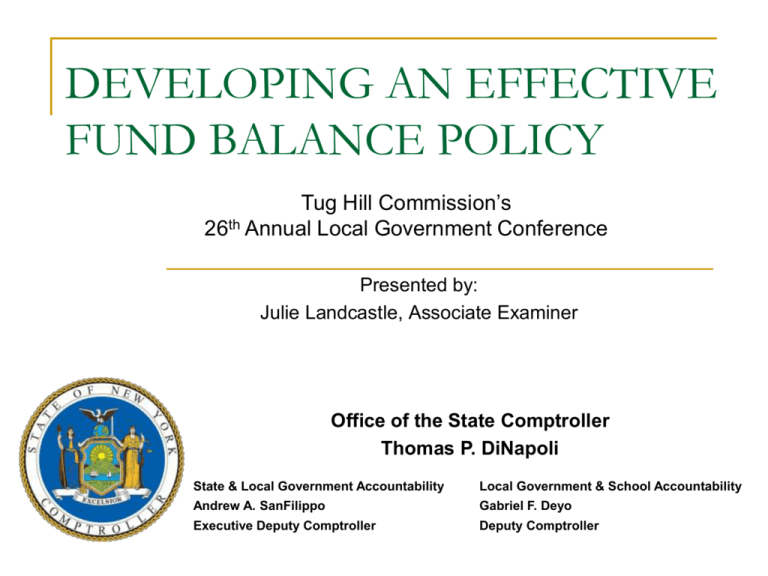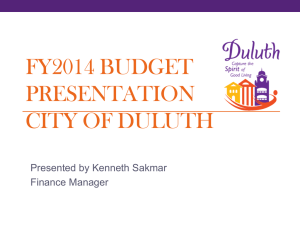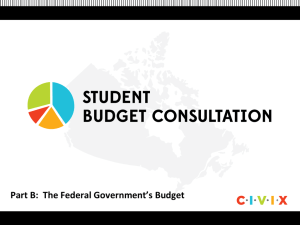developing an effective fund balance policy
advertisement

DEVELOPING AN EFFECTIVE FUND BALANCE POLICY Tug Hill Commission’s 26th Annual Local Government Conference Presented by: Julie Landcastle, Associate Examiner Office of the State Comptroller Thomas P. DiNapoli State & Local Government Accountability Local Government & School Accountability Andrew A. SanFilippo Gabriel F. Deyo Executive Deputy Comptroller Deputy Comptroller Learning Objectives What Is Fund Balance? History of Fund Balance Legislation What Are the Components of Fund Balance? Benefits of a Fund Balance Policy What Is a “Reasonable Amount” of Fund Balance? Keeping Fund Balance at Desired Levels Fund Balance – What Is It? Fund Balance is the total accumulation of operating surpluses and deficits since the beginning of a local government’s existence. $120,000 $100,000 $80,000 Revenues Expenditures Fund Balance $60,000 $40,000 $20,000 $0 2009 2010 2011 2012 Excessively Low Fund Balance Normally caused by: Can result in: Poor budget practices Desire to reduce taxes, or keep them at same level Political reasons Short-term borrowing (RANs, TANs, Budget Notes) Deficit financing Credit rating reduction Should be increased in conformity with long-term plans Excessively High Fund Balance Normally caused by: Poor budget practices Unduly high property taxes Political reasons Greater opportunity for fraud if controls are weak Should be appropriated or reduced in conformity with long-term plans Components of Fund Balance Total Fund Balance is comprised of two components: Restricted Fund Balance – that portion that has been legally set aside for a specific purpose by the governing board (e.g. – GML reserve funds) and any portion that is considered non-spendable (e.g., inventory, pre-paid expenses) Unrestricted Fun Balance –Total Fund Balance less Restricted Fund Balance This is the portion of Fund Balance that Boards have some discretion with at budget time Fund Balance Limits Prior to January 2001 Counties, towns, villages and fire districts had no legal authority to carry over any unappropriated / unreserved balance Chapter 528 of the Laws of 2000 Bill submitted by Comptroller to provide mandate relief and greater flexibility to local governments. Counties, towns, villages and fire districts can carry over a “reasonable amount” of unreserved / unappropriated fund balance Legislative Intent - Prior to 2001 Public Policy Underlying Rule of Law: Governments need to make a full accounting of all public funds and prevent municipal governments from collecting taxes faster than they are needed. Municipal governments should not accumulate funds for the remote future or for contingencies which may never occur. Protection provided to taxpayers from misuse of surplus funds to hide deficit spending or to reap political gain. So Why the Change? Legislators recognized the need to set aside a portion of unrestricted fund balance in order to reduce the cost of borrowing, stabilize taxes and enhance credit ratings. Legislators also recognized the potential for abuse if local governments were allowed to amass excessive fund balances. An OSC July 2001 accounting bulletin recommended each local government assess what is a “reasonable amount” for its particular situation and adopt a fund balance policy. Benefits of a Fund Balance Policy Provides for an orderly provision of services. Provides taxpayers with information about why resources have been set aside. Provides a framework to help guide budgetary decisions and multi-year plans. Helps ensure an adequate fund balance is available to: Ensure efficient cash flow for daily needs Protect against unforeseen expenditures related to emergencies Offset economic downturns or revenue shortfalls Maintain investment-grade bond rating. Effective Fund Balance Policies Should: Be adopted by the governing board with input from key officials (e.g., CFO, budget officer). Be in written form and subject to review by governing board on a regular basis. Be used to develop and amend multi-year capital and operational plans. Address how surplus balances will be applied. Address the timing for balances to be replenished to the desired level. “Reasonable” Factors to Consider Composition of the fund balance (is it all cash?) Timing of receipts and disbursements Volatility of revenues and expenditures Contingent appropriations Established reserves Potential for one-time outlays not provided for by reserves Dependence on resources from other funds as well as the need to provide resources to other funds Size of the fund Experience in prior fiscal years Common Methods Used to Calculate a “Reasonable Amount” * Percentage of Expenditures or Revenues Expenditures or Revenues for a set number of months Example: 15% of annual operating expenditures Example: Total estimated expenditures for the first two months of the fiscal year Specific dollar amount *OSC does not recommend any one method or amount – these decisions are the responsibility of each local government based on its own situation. Estimating Available Fund Balance General Fund Fund Balance @ 1/01/XX + Revenues to date (8/31/xx) - Expenditures to date (8/31/xx) Balance to date $782,005 $916,870 $1,151,525 $547,350 + Projected Revenues (9/1/ -12/31/XX) $177,004 - Projected Expenditures (9/1/-12/31/XX) $125,349 Estimated Fund Balance at Year-End – 12/31/XX* $599,005 Composition of Estimated Fund Balance @ 12/31/XX: Restricted (Capital Reserve -$175,000 + Prepaid Insurance - $12,500) $187,500 Unrestricted $411,505 * Fund balance must be able to be converted to cash within the first 2 months of the fiscal year Budget Requirement County Law §355((g); Town Law § § 107(1)(b), 181(2)(b); Village Law §5-506(1)(c) Each municipal budget MUST contain: A statement for each fund of the fund balance estimated to be on hand at the close of the current fiscal year, together with a breakdown of such fund balance estimated for: Encumbrances Amount appropriated for ensuing year’s budget Amounts reserved for stated purpose Remaining unappropriated amount, not to exceed a “reasonable amount”. Schedule of Estimated Fund Balances General (A) Highway (DA) Water Dist (SW) Estimated Total Fund Balance @ 12/31/12 $599,005 $786,990 $76,650 Nonspendable Portion (Prepaid Insurance) $12,500 $7,800 $0 Capital Reserve $175,000 $75,000 $0 Repair Reserve $0 $50,000 $22,000 $411,505 $654,190 $54,650 $100,000 $170,000 $10,000 $484,190 $44,650 Restricted Fund Balance: Total Estimated Unrestricted FB @ 12/31/12 Amount appropriated toward 2013 Budget Unappropriated / Unrestricted FB $311,505 A Four-Pronged Approach to Managing Excess Unrestricted Fund Balance Fund Balance One-Shot Expenditures Expenditures that do not normally occur annually, such as: Equipment and capital outlay expenditures (.2) Court-ordered judgments Extraordinary public service contracts (legal, assessor, etc.). Reduce Debt Principal Decreases future interest payments Shortens life of the loan Improves credit ratings Note: Since not all debt instruments allow for the reduction of principal ahead of schedule, local governments should check with their lender or bond counsel before pursuing this option. Finance Reserve Funds Reserves must be legally established General Municipal Law (§§ 6-c through 6-r) Town Law (§§ 55, 55-a, 55-b) County Law (§ 372). Reserves should be limited to amounts specified in resolution or other statutory limitations. Establishment and use of reserves should be linked to long-term capital and operational plans. Reduce Property Taxes Be cautious (one-shot revenues should not be used to fund recurring expenditures) Consider budgetary practices Operating surpluses (deficits) Can result in unstable tax rates Link to long-term plans Appropriated Fund Balance (a.k.a. Planned Deficit) 2009 Beginning Unrestricted FB Budgeted Appropriations Estimated Revenues Appropriated FB Tax Levy Budgeted Operating Deficit Actual Operating Surplus (Deficit) 2010 2011 2012 $440,000 $335,000 $198,600 $ 41,430 $1,300,000 $1,339,000 $1,379,17 0 $1,379,170 $780,000 $750,000 $815,000 $820,000 $90,000 $159,000 $134,170 $41,430 $430,0000 $430,000 $430,000 $517,740 ($90,000) ($159,000) ($134,170) ($41,430) ($105,000) ($136,400) ($157,170) ? $87,740 increase in taxes (20%) $0 available to offset 2012 revenue shortfalls and/or unexpected expenditures Replenishing Unrestricted Fund Balance Budgetary Provisions When possible - replenish to desired levels in next fiscal year budget When not possible – develop a plan to replenish to desired level over a period of years (e.g., 3 years) Maximum use of contingent account and apply budget surpluses to replenish fund balance One-Shot Revenues Sale of equipment & property Gifts / donations Questions? Contact the Syracuse Regional Office Muni-Syracuse@osc.state.ny.us 315-428-4192






